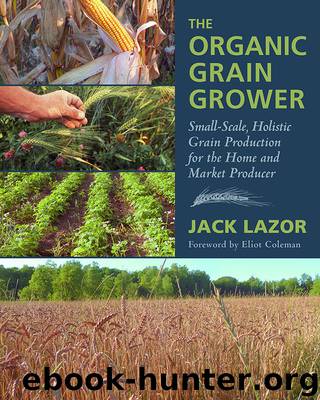The Organic Grain Grower by Jack Lazor

Author:Jack Lazor
Language: eng
Format: epub
ISBN: 978-1-60358-366-4
Publisher: Chelsea Green Publishing
Published: 2013-07-25T16:00:00+00:00
The layout of a typical millstone.
Most millstones were covered on top and surrounded by a wooden skirt of boards to contain flour and dust during the milling process. A wooden hopper was positioned on top of the mill to contain the wheat that was destined to be ground below. Wheat kernels dropped through a regulated gate in the hopper down through the eye of the revolving top stone. The grinding process began once the wheat fell into the ingeniously designed pattern of grooves in the two stones.
It is interesting to note that the chiseled grooves radiate in a tangential pattern from the center of the millstones in order that they can readily move wheat kernels from the eye in the center to the outside circumference. These grinding channels are cut much deeper into the stone at its center point to accommodate whole kernels of wheat that are falling through the eye of the runner stone above. This is where the craft of the millstone dresser reigns supreme. The grinding channels get narrower and shallower as they radiate outward. These milling grooves are specially configured with a right-angled leading edge and a tapered trailing edge. The runner and bed stones are dressed identically with the exact same pattern of lands and furrows, which is very apparent if you lift the runner stone off the bed stone and lay it face-up next to its mate: The two stones look like identical twins. However, once the runner stone is lifted and repositioned on top of the bed stone, the patterns of the grinding channels will be diametrically opposed. This configuration of grinding channels scraping across each other is what grinds the wheat into flour.
The kernels of wheat begin their grinding journey in the deeper center grooves, where they are chopped into smaller pieces. A well-dressed sharp stone will actually scrape the exterior bran off the wheat kernel in large flakes. The remaining endosperm continues traveling outward and is pulverized by shallower cross channels (lands) into smaller and smaller pieces until it becomes fine flour at the very outer edge of the millstones. The flour is propelled outward by centrifugal force and built-up air pressure that enters the grinding stones from the eye and exhausts itself at the outer circumference.
Stone Flour Mills
Horizontal stone flour milling is a bit of a lost art these days for a variety of reasons. This is “slow food” at its best, and the finest-quality flours come from this type of milling process. These millstones rotate at a rather low 120 to 125 revolutions per minute. Flour will never heat when ground on large-diameter slowly revolving millstones. Heat is the enemy of good flour because high grinding temperatures will cause the oil in the wheat germ to go rancid. However, total output of flour in this system is rather low; a set of four-foot-diameter millstones will not grind more than three hundred pounds of flour per hour. Everything about modern industrial food production runs counter to the artisan miller of yesteryear.
Download
This site does not store any files on its server. We only index and link to content provided by other sites. Please contact the content providers to delete copyright contents if any and email us, we'll remove relevant links or contents immediately.
| Automotive | Engineering |
| Transportation |
Whiskies Galore by Ian Buxton(41884)
Introduction to Aircraft Design (Cambridge Aerospace Series) by John P. Fielding(33064)
Small Unmanned Fixed-wing Aircraft Design by Andrew J. Keane Andras Sobester James P. Scanlan & András Sóbester & James P. Scanlan(32744)
Craft Beer for the Homebrewer by Michael Agnew(18145)
Turbulence by E. J. Noyes(7941)
The Complete Stick Figure Physics Tutorials by Allen Sarah(7310)
Kaplan MCAT General Chemistry Review by Kaplan(6868)
The Thirst by Nesbo Jo(6832)
Bad Blood by John Carreyrou(6555)
Modelling of Convective Heat and Mass Transfer in Rotating Flows by Igor V. Shevchuk(6391)
Learning SQL by Alan Beaulieu(6212)
Weapons of Math Destruction by Cathy O'Neil(6148)
Man-made Catastrophes and Risk Information Concealment by Dmitry Chernov & Didier Sornette(5924)
Digital Minimalism by Cal Newport;(5667)
Life 3.0: Being Human in the Age of Artificial Intelligence by Tegmark Max(5476)
iGen by Jean M. Twenge(5367)
Secrets of Antigravity Propulsion: Tesla, UFOs, and Classified Aerospace Technology by Ph.D. Paul A. Laviolette(5310)
Design of Trajectory Optimization Approach for Space Maneuver Vehicle Skip Entry Problems by Runqi Chai & Al Savvaris & Antonios Tsourdos & Senchun Chai(5011)
Pale Blue Dot by Carl Sagan(4913)
